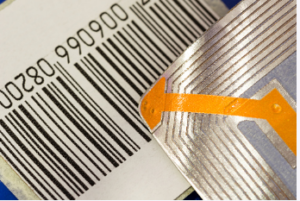RFID tracking takes inventory management, monitoring, and tracking to a new level. By strategically placing fixed RFID readers around their facility, companies can automatically transmit inventory data directly into a system accessible locally via laptop or remotely from anywhere around the globe.
 RFID tracking eliminates the need for line-of-sight scanners and allows workers to quickly find items for replenishing stores.
RFID tracking eliminates the need for line-of-sight scanners and allows workers to quickly find items for replenishing stores.
Reduced labour costs
Employees using RFID tracking don’t need to spend as much time scanning and tracking products manually, freeing them up for better customer service, leading to happier clients and increased revenue. Furthermore, RFID helps reduce employee mistakes which helps cut labour costs associated with keeping track of inventory and assets.
Rental companies renting high-value equipment like drills often struggle with inaccurate records and unreliable inventory management methods. When employees check out multiple drills but fail to return them, labour costs increase substantially while time slips away from them wasting away. RFID tracking solves this problem efficiently, providing rental businesses with accuracy, speed, and efficiency.
RFID also allows companies to eliminate cycle counting, a time-consuming task that requires employees to scan each item manually. Automating the process saves companies time and money compared to manually performing this task.
RFID can penetrate most packaging materials, eliminating the need for manual data entry during inventory receipt or item selection for delivery. This feature makes RAMPRFID RFID tracking particularly beneficial to fulfilment centres that process many small orders, enabling employees to complete more tasks during each shift.
Improved inventory accuracy
RFID’s automation, quick scans, and reduced manual labour help minimise human error – this leads to improved inventory accuracy and increases productivity across supply chain processes such as shipment verification, tracking inventory counts and counting processes.
Fashion retailers can quickly locate lost garments using RFID to pinpoint their locations within a warehouse. It saves time searching through thousands of SKUs, improving customer experience by reducing out-of-stock situations and increasing revenue.
Technology like this also provides real-time inventory updates in warehouses or retail stores, helping retailers improve operations by making smarter decisions about production, ordering, pricing and inventory levels – as well as reducing shrinkage by pinpointing where the product was last seen and when.
Barcode inventory counts can often take several hours or days; with RFID, this process can usually be completed within minutes. RFID scanners read tags from much further away than barcode scanners and use automation to speed up scanning and cataloguing data faster. It enables companies to eliminate tedious manual counts while decreasing errors that could otherwise lead to lost sales claims costs in downstream supply chains or unhappy customers – thus making RFID a cost-effective investment that increases revenue while reducing expenses over time.
Reduced theft
RFID provides increased inventory accuracy by eliminating the need for teams of people to log assets manually, thus eliminating opportunities for human error that result in misplaced or lost items, which costs money, decreases productivity and contributes to customer frustration.
RFID data gives your business a clearer view of how items move throughout, giving a more accurate representation of how products and materials flow. It can help identify bottlenecks in production processes or distribution systems and correct them. For example, suppose high-value items regularly go missing or materials take too long to return from vendors. In that case, RFID data can provide insight into why and implement preventive systems to minimise losses.
RFID item-level tagging helps retailers protect themselves against internal employee theft and external shoplifting. Customers passing by a RAMPRFID RFID tracking detector with an active tag will set off an alarm either physically or electronically to indicate they haven’t paid for their purchases; when combined with video surveillance, this technique can even help identify perpetrators and build cases against them.
RFID technology can also aid in the prevention of returns fraud. By tracking when items with RFID chips are returned for refund or store credit, combined sales and video surveillance, data can reveal when and where things have been stolen and returned for store credit – providing additional insight into loss prevention measures in your stores.
Better customer service
Businesses that accurately track inventory can focus more on customer satisfaction; according to a 2022 Statista study, companies with more efficient stock management had higher customer service satisfaction ratings.